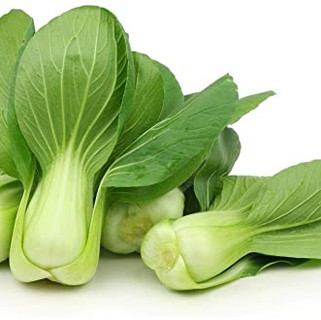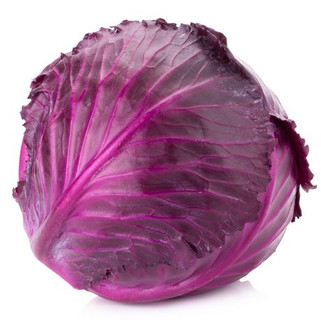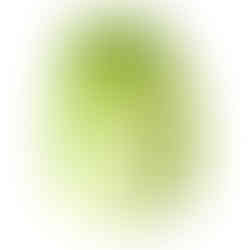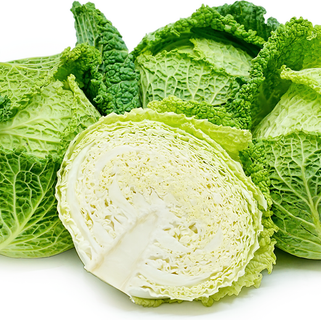Cabbage Benefits - The World's Most Common Types Of Cabbage
- Michael Constantine
- Apr 12, 2020
- 10 min read
Cabbage is a leafy green, red, or white biennial plant grown as an annual vegetable crop for its dense-leaved heads. It is descended from the wild cabbage, and belongs to the "cole crops" or brassicas, meaning it is closely related to broccoli and cauliflower; Brussels sprouts; and Savoy cabbage.
There are over 400 Cabbage varieties.
Cannonball Cabbage
More commonly known as green cabbage, the cannonball cabbage is one of the most popular cabbage varieties. It is so named for the way its leaves wound tightly over one another in a dense, compact fashion; with the final product resembling a cannonball.
Prep tip: Its dense leaves make it perfect for shredding into coleslaw or fermented into sauerkraut. It is also delicious braised, stewed or boiled in a simple soup with chopped-up cabbage, carrots, corn and pork ribs.

Bok Choy
You may know it as bok choy, bai cai or pak choi but they all really mean the same thing: a dark, leafy vegetable with slender stems that's more reminiscent of Swiss chard or spinach than it is a cannonball cabbage.
Prep tip: The delicate flavour of bok choy shines through in a simple stir-fry of minced garlic, oyster sauce and salt to taste.

Choy Sum
You may know it as choy sum or cai xin, depending on your mother tongue; in which, the Cantonese and Mandarin transliteration of its name is "heart of the vegetable". The leafy veggie appears similar to kai lan and its Chinese cabbage sibling, bok choy, but can be easily recognised by the distinctive yellow flowers it bears.
Prep tip: A gentle blanch in hot, salted water will help the vegetable retain the integrity of its crisp stems and soft leaves.

Napa Cabbage
Oblong in shape with frilly, yellow-green leaves, this cabbage variety is sweeter and softer than the other varieties and is widely used in East Asian cuisine.
Prep tip: There are over 180 varieties of kimchi and probably the most popular of all is the baechu-kimchi, which is made with salted, seasoned, and fermented napa cabbage

Savoy Cabbage (Purple - Green)
Probably the most photogenic of the cabbages is this lacy variant. The leaves of the savoy cabbage are more loosely layered and less tightly packed than green or red cabbage, which gives it a shorter shelf life.
Prep tip:Savoy cabbage is more tender than the other cabbages and eat beautifully as a fresh, crunchy wrap or braised in butter and stock. But one of our favourite ways to prepare the savoy cabbage is by steaming its leaves and wrapping it around a filling of minced meat and rice; a dish the Polish call golabki and Czechs and Slovaks, holubky.

January King Cabbage
Don't confused this purple-green beauty for the red cabbage. The colours on this curly-leafed vegetable differ from head to head and can range from deep, royal purples to cool, crisp turquoises. And as its name suggests, the cabbage is a hardy vegetable that's usually planted in autumn and harvested in winter.
Prep tip:We find it tastiest when roasted with a liberal amount of butter, seasoning and spices but you can prepare it as you would a savoy.

Red Cabbage
Also known as the purple cabbage or red kraut, the red cabbage changes its colour according to the pH value of the soil it grows in - the leaves grow reddish in acidic soil and more purplish in neutral - acting as a litmus test of sorts.
Prep tip:Red cabbage turns blue-grey as it cooks and colour pigments break down but you can easily mitigate this by adding some form of acid (lemon juice or vinegar) to it in a cook. It is delicious when sliced thinly into salads like coleslaw, braised with some bacon, apple cider vinegar and apples or fermented into sauerkraut.

9 Impressive Health Benefits of Cabbage
Despite its impressive nutrient content, cabbage is often overlooked.
While it may look a lot like lettuce, it actually belongs to the Brassica genus of vegetables, which includes broccoli, cauliflower and kale .
It comes in a variety of shapes and colors, including red, purple, white and green, and its leaves can be either crinkled or smooth.
This vegetable has been grown around the world for thousands of years and can be found in a variety of dishes, including sauerkraut, kimchi and coleslaw.
Additionally, cabbage is loaded with vitamins and minerals.
This article uncovers 9 surprising health benefits of cabbage, all backed by science.

Even though cabbage is very low in calories, it has an impressive nutrient profile.
In fact, just 1 cup (89 grams) of raw green cabbage contains :
Calories: 22
Protein: 1 gram
Fiber: 2 grams
Vitamin K: 85% of the RDI
Vitamin C: 54% of the RDI
Folate: 10% of the RDI
Manganese: 7% of the RDI
Vitamin B6: 6% of the RDI
Calcium: 4% of the RDI
Potassium: 4% of the RDI
Magnesium: 3% of the RDI
Cabbage also contains small amounts of other micronutrients, including vitamin A, iron and riboflavin.
As you can see in the list above, it is rich in vitamin B6 and folate, both of which are essential for many important processes in the body, including energy metabolism and the normal functioning of the nervous system.
In addition, cabbage is high in fiber and contains powerful antioxidants, including polyphenols and sulfur compounds .
Antioxidants protect the body from damage caused by free radicals. Free radicals are molecules that have an odd number of electrons, making them unstable. When their levels become too high, they can damage your cells.
Cabbage is especially high in vitamin C, a potent antioxidant that may protect against heart disease, certain cancers and vision loss .
Summary Cabbage is a low-calorie vegetable that is rich in vitamins, minerals and antioxidants.
2. It May Help Keep Inflammation in Check
Inflammation isn’t always a bad thing.
In fact, your body relies on the inflammatory response to protect against infection or speed up healing. This kind of acute inflammation is a normal response to an injury or infection.
On the other hand, chronic inflammation that occurs over a long period of time is associated with many diseases, including heart disease, rheumatoid arthritis and inflammatory bowel disease .
Cruciferous vegetables like cabbage contain many different antioxidants that have been shown to reduce chronic inflammation .
In fact, research has shown that eating more cruciferous vegetables reduces certain blood markers of inflammation .
One study including over 1,000 Chinese women showed that those who ate the highest amounts of cruciferous vegetables had considerably lower levels of inflammation, compared to those who ate the lowest amounts .
Sulforaphane, kaempferol and other antioxidants found in this remarkable group of plants are likely responsible for their anti-inflammatory effect.
Summary Cabbage contains powerful antioxidants that may help reduce inflammation.
Vitamin C, also known as ascorbic acid, is a water-soluble vitamin that serves many important roles in the body.
For instance, it’s needed to make collagen, the most abundant protein in the body. Collagen gives structure and flexibility to the skin and is critical for the proper functioning of the bones, muscles and blood vessels .
Additionally, vitamin C helps the body absorb non-heme iron, the type of iron found in plant foods.
What's more, it’s a powerful antioxidant. In fact, it has been extensively researched for its potential cancer-fighting qualities .
Vitamin C works to protect the body from damage caused by free radicals, which has been associated with many chronic diseases, including cancer .
Evidence suggests that a diet high in vitamin-C-rich foods is associated with a lower risk of certain cancers .
In fact, a recent analysis of 21 studies found that the risk of lung cancer decreased by 7% for each daily 100-mg increase in vitamin C intake .
However, this study was limited because it could not determine whether the decreased risk of lung cancer was caused by vitamin C or other compounds found in fruits and vegetables.
While many observational studies have found a link between higher vitamin C intake and a reduced risk of certain cancers, results from controlled studies remain inconsistent .
Even though more research is needed to determine this vitamin's role in cancer prevention, it’s certain that vitamin C plays a key role in many important functions in the body.
While both green and red cabbage are excellent sources of this potent antioxidant, red cabbage contains about 30% more.
One cup (89 grams) of chopped red cabbage packs in 85% of the recommended intake for vitamin C, which is the same amount found in a small orange .
Summary Your body needs vitamin C for many important functions, and it is a potent antioxidant. Red cabbage is particularly high in this nutrient, providing about 85% of the RDI per cup (89 grams).
If you want to improve your digestive health, fiber-rich cabbage is the way to go.
This crunchy vegetable is full of gut-friendly insoluble fiber, a type of carbohydrate that can’t be broken down in the intestines. Insoluble fiber helps keep the digestive system healthy by adding bulk to stools and promoting regular bowel movements .
What’s more, it's rich in soluble fiber, which has been shown to increase the number of beneficial bacteria in the gut. This is because fiber is the main fuel source for friendly species like Bifidobacteria and Lactobacilli .
These bacteria perform important functions like protecting the immune system and producing critical nutrients like vitamins K2 and B12 .
Eating more cabbage is an excellent way to keep your digestive system healthy and happy.
Summary Cabbage contains insoluble fiber, which keeps the digestive system healthy by providing fuel for friendly bacteria and promoting regular bowel movements.
Red cabbage contains powerful compounds called anthocyanins. They give this delicious vegetable its vibrant purple color.
Anthocyanins are plant pigments that belong to the flavonoid family.
Many studies have found a link between eating foods rich in this pigment and a reduced risk of heart disease .
In a study including 93,600 women, researchers found that those with a higher intake of anthocyanin-rich foods had a much lower risk of a heart attack .
Another analysis of 13 observational studies that included 344,488 people had similar findings. It found that increasing flavonoid intake by 10 mg per day was associated with a 5% lower risk of heart disease .
Increasing your intake of dietary anthocyanins has also been shown to reduce blood pressure and the risk of coronary artery disease .
Inflammation is known to play a major role in the development of heart disease, and anthocyanins' protective effect against it is likely due to their anti-inflammatory qualities.
Cabbage contains more than 36 different kinds of potent anthocyanins, making it an excellent choice for heart health .
Summary Cabbage contains powerful pigments called anthocyanins, which have been shown to reduce the risk of heart disease.
6. May Lower Blood Pressure
High blood pressure affects more than one billion people worldwide and is a major risk factor for heart disease and stroke .
Doctors often advise patients with high blood pressure to reduce their salt intake. However, recent evidence suggests that increasing your dietary potassium is just as important for lowering blood pressure .
Potassium is an important mineral and electrolyte that the body needs to function properly. One of its main jobs is to help regulate blood pressure by counteracting the effects of sodium in the body .
Potassium helps excrete excess sodium through urine. It also relaxes blood vessel walls, which lowers blood pressure.
While both sodium and potassium are important for health, modern diets tend to be too high in sodium and too low in potassium .
Red cabbage is an excellent source of potassium, delivering 12% of the RDI in a 2-cup (178-gram) serving .
Eating more potassium-rich cabbage is a delicious way to lower high blood pressure and may help keep it within a healthy range .
Summary Potassium helps keep blood pressure within a healthy range. Increasing your intake of potassium-rich foods like cabbage may help lower high blood pressure levels.
Cholesterol is a waxy, fat-like substance found in every cell in your body.
Some people think all cholesterol is bad, but it’s essential for the body’s proper functioning.
Critical processes depend on cholesterol, such as proper digestion and the synthesis of hormones and vitamin D.
However, people who have high cholesterol also tend to have an increased risk of heart disease, especially when they have elevated levels of “bad” LDL cholesterol .
Cabbage contains two substances that have been shown to decrease unhealthy levels of LDL cholesterol.
Soluble Fiber
Soluble fiber has been shown to help lower “bad” LDL cholesterol levels by binding with cholesterol in the gut and keeping it from being absorbed into the blood.
A large analysis of 67 studies showed that when people ate 2–10 grams of soluble fiber per day, they experienced a small, yet significant, decrease in LDL cholesterol levels of roughly 2.2 mg per deciliter.
Cabbage is a good source of soluble fiber. In fact, around 40% of the fiber found in cabbage is soluble .
Plant Sterols
Cabbage contains substances called phytosterols. They are plant compounds that are structurally similar to cholesterol, and they reduce LDL cholesterol by blocking the absorption of cholesterol in the digestive tract.
Increasing phytosterol intake by 1 gram per day has been found to reduce LDL cholesterol concentrations by as much as 5% .
Summary Cabbage is a good source of soluble fiber and plant sterols. These substances have been shown to reduce LDL cholesterol.
Vitamin K is a collection of fat-soluble vitamins that plays many important roles in the body.
These vitamins are divided into two main groups .
Vitamin K1 (phylloquinone): Found primarily in plant sources.
Vitamin K2 (menaquinone): Found in animal sources and some fermented foods. It is also
produced by bacteria in the large intestine.
Cabbage is a terrific source of vitamin K1, delivering 85% of the recommended daily amount in a single cup (89 grams) .
Vitamin K1 is a key nutrient that plays many important roles in the body.
One of its main functions is to act as a cofactor for enzymes that are responsible for clotting the blood .
Without vitamin K, the blood would lose its ability to clot properly, increasing the risk of excessive bleeding.
Summary Vitamin K is critical for blood clotting. Cabbage is an excellent source of vitamin K1, with 85% of the RDI in 1 cup (89 grams).
In addition to being super healthy, cabbage is delicious.
It can be eaten raw or cooked and added to a wide variety of dishes like salads, soups, stews and slaws.
This versatile veggie can even be fermented and made into sauerkraut.
In addition to being adaptable to many recipes, cabbage is extremely affordable.
No matter how you prepare cabbage, adding this cruciferous vegetable to your plate is a tasty way to benefit your health.
Summary Cabbage is a versatile veggie that’s easy to incorporate into your diet. You can use it to make many different dishes, including salads, stews, soups, slaws and sauerkraut.
The Bottom Line
Cabbage is an exceptionally healthy food.
It has an outstanding nutrient profile and is especially high in vitamins C and K.
In addition, eating cabbage may even help lower the risk of certain diseases, improve digestion and combat inflammation.
Plus, cabbage makes a tasty and inexpensive addition to a number of recipes.
With so many potential health benefits, it is easy to see why cabbage deserves some time in the spotlight and some room on your plate.

















Comments